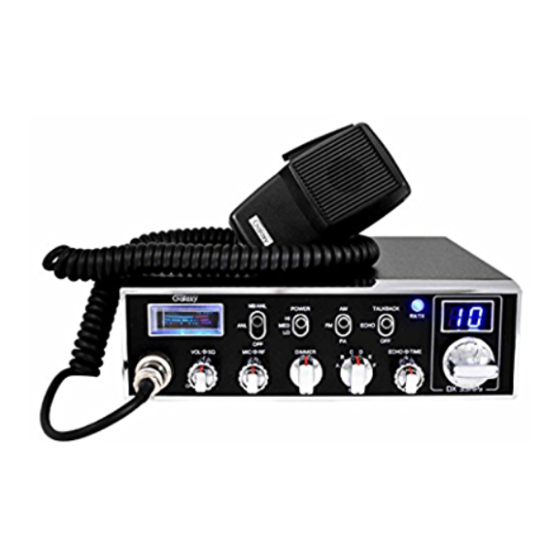Galaxy DX−33HML Panduan Pemilik - Halaman 8
Jelajahi secara online atau unduh pdf Panduan Pemilik untuk Transceiver Galaxy DX−33HML. Galaxy DX−33HML 8 halaman. Full channel am/fm mobile transceiver

D. Try a different location on your car (keeping in mind the radiation pattern
you wish)
E. Is the antenna perfectly vertical?
F. Try a different location in your neighborhood. Stay away from large
metal objects when adjusting (metal telephone or light posts, fences, etc.).
The transceiver will operate into an SWR of 2 to 1 indefinitely
and sustain an SWR of 20:1 for a maximum of 5 minutes at rated
operating conditions.
EXTERNAL SPEAKER
The external speaker jack (EXT.SPK) on the rear panel is used for remote
receiver monitoring. The external speaker should have 8 ohms impedance and be
able to handle at least 4 watts. When the external speaker is plugged in, the internal
speaker is disconnected.
NOTE
- 7 -
Operation
CONTROL FUNCTIONS
There are thirteen controls and three indicators on the front panel of your
transceiver.
FRONT PANEL
1. OFF/ON/VOLUME (inner dual concentric). Turn clockwise to apply power
to the unit and to set the desired listening level. During normal operation, the
VOLUME control is used to adjust the output level obtained either at the
transceiver speaker or the external speaker, if used.
2. SQUELCH (outer dual concentric). This control is used to cut off or
eliminate receiver background noise in the absence of an incoming signal. For
maximum receiver sensitivity it is desired that the control be adjusted only to
the point where the receiver background noise or ambient backgrounds noise is
eliminated. Turn fully counterclockwise then slowly clockwise until the
receiver noise disappears. Any signal to be received must now be slightly
stronger than the average received noise. Further clockwise rotation will
increase the threshold level, which a signal must overcome in order to be
heard. Only strong signals will be heard at a maximum clockwise setting.
3. MIC GAIN (inner dual concentric). Adjust the microphone gain in the
transmit and PA modes. This controls the gain to the extent that full talk power
is available several inches away from the microphone.
4. RF GAIN CONTROL (outer dual concentric). Use to reduce the gain of the
RF amplifier under strong signal conditions.
- 8 -
